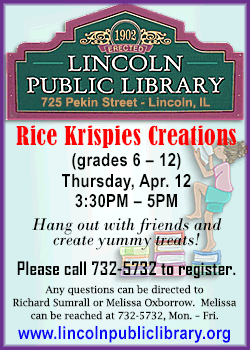|
 Winners in the online voting include the steel plow,
which opened the prairies to agricultural development, and barbed
wire, which transformed farming and ranching nationwide. Winners in the online voting include the steel plow,
which opened the prairies to agricultural development, and barbed
wire, which transformed farming and ranching nationwide.
Voters also recognized the impact of the birth-control pill, which
changed both individual lives and American society, and the blood
bank, an idea that has saved countless lives. Contributions to
computer science and communications technology were honored, too,
with voters putting cell phones and early experiments in
computer-assisted education on the list.
But voters turned thumbs-down to the state’s more frivolous
contributions. Twinkies, pinball and the television remote control
all failed to make the cut.
The Illinois Top 200 project lets Illinoisans vote every two weeks
on the most inspiring leaders, greatest books, top businesses and
much more. By the state’s 200th birthday on Dec. 3, voters will have
chosen 10 favorites in 20 different categories – the Illinois Top
200.

Voting in the next category, top buildings, is underway at
www.IllinoisTop200.com. Nominees include Chicago skyscrapers, homes
designed by Frank Lloyd Wright, the state’s oldest building and two
religious shrines.
Here are the top 10 Illinois inventions and innovations:
1. Steel Plow – Early settlers in prairie states faced a big
problem: Their cast-iron plows bogged down in the thick, sticky
soil. Then blacksmith John Deere thought of trying steel in 1837.
His new design cut through the soil easily.
2. Cell Phone – You can thank “Star Trek” and Motorola for
that cell phone you carry. A Motorola engineer was inspired by “Star
Trek” communicators to create the first cell phone in 1973. A
consumer version debuted 10 years later.
3. Birth Control – Development of the Pill goes back to 1952,
when noretynodrel was synthesized at G.D. Searle in Skokie. In 1960
it was approved for use as birth control.
4. Skyscraper – The world’s first skyscraper was erected in
Chicago in 1885. Ever since, Chicago architects and developers have
pushed skyscrapers to new heights and new artistic significance.
5. Blood Bank – In 1937 Bernard Fantus looked at recent
progress in blood science and came up with an idea: a place to store
blood until it was needed. He opened the first American blood bank
at Cook County Hospital in Chicago.
6. Mail Order – Until 1872, rural shoppers basically had no
choice but to shop at the local store and pay its prices. Then came
Aaron Montgomery Ward of Chicago, who introduced the idea of
shopping from catalogs.
7. Barbed Wire –
Inventors had been tinkering with the idea of barbed wire for years
before Joseph Glidden of DeKalb came up with a practical version in
1874. His invention made it possible to control livestock and
protect crops.

[to top of second column] |

8. Silo – They’re so common today that it’s easy to assume silos have
always been part of farming, but they’re actually less than 150 years old. Until
Fred Hatch built the first tower silo in 1873 near Spring Grove, grain was
usually stored in pits.
9. Meatpacking – The modern meatpacking industry began in Chicago, whose
position as a railway center made it ideal for bringing in livestock, butchering
it, then sending it around the country. It changed the way America ate.
10. Computer-Assisted Education – The first general computer-assisted
learning system originated at the University of Illinois in 1960. By the late
1970s, PLATO (for Programmed Logic for Automatic Teaching Operations) was
offering courses on terminals around the world.
The Illinois Top 200 is a joint initiative of the Abraham Lincoln Presidential
Library and Museum, The (Springfield) State Journal-Register and the Illinois
Bicentennial Commission.
Future categories include authors, musicians, actors, leaders, buildings and
unforgettable moments. Everyone is invited to suggest possible nominees in each
category by using the hashtag #ILtop200 on social media.
ABOUT ABRAHAM LINCOLN PRESIDENTIAL LIBRARY AND MUSEUM
The presidential library and museum uses a combination of rigorous scholarship
and high-tech showmanship to immerse visitors in Lincoln’s life and times.
Visitors can see ghosts come to life on stage, watch TV coverage of the 1860
Presidential election, roam through the Lincoln White House, experience booming
cannons in a Civil War battle and come face to face with priceless original
Lincoln artifacts.

The library holds an unparalleled collection of Lincoln books, documents,
photographs, artifacts and art, as well as some 12 million items pertaining to
all aspects of Illinois history.
For more information, visit
www.PresidentLincoln.illinois.gov.
ABOUT ILLINOIS BICENTENNIAL
On Dec. 3, 1818, Illinois became the 21st state in the union. The Illinois
Bicentennial is a yearlong celebration of what has been BORN, BUILT & GROWN in
the state and a reminder of why we are #IllinoisProud. Citizens are encouraged
to participate in the celebration by visiting
www.illinois200. com and using
the hashtag #IllinoisProud. Partners and event and project managers planning
activities between Dec. 3, 2017, and Dec. 3, 2018, can apply for endorsement to
become an official part of Illinois Bicentennial by visiting the PARTICIPATE
page at www.illinois200.com.
[Christopher Wills] |